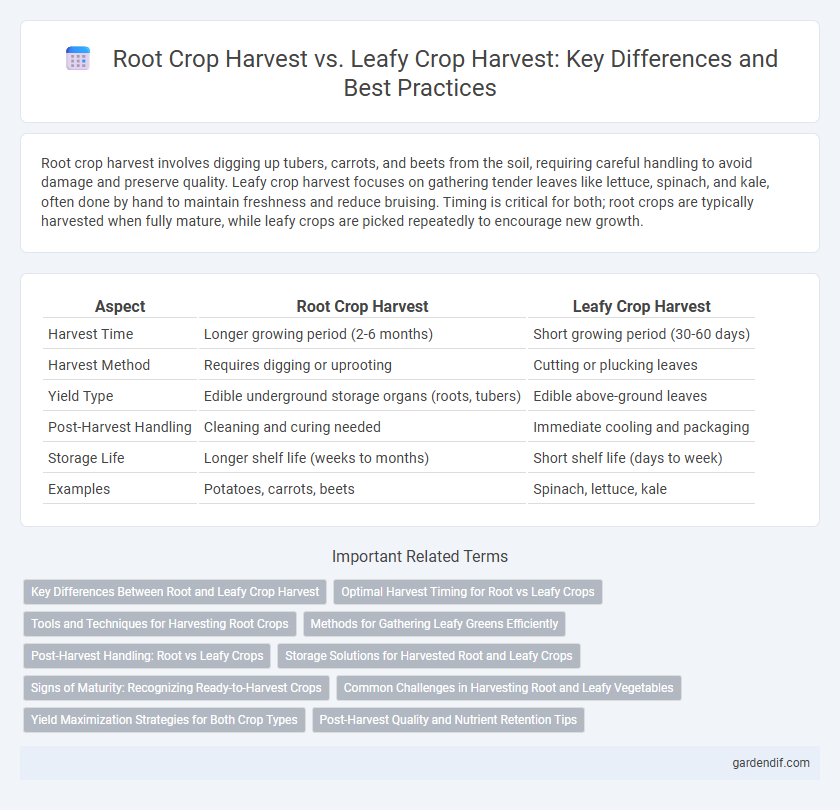
Root Crop Harvest vs Leafy Crop Harvest Illustration
Root crop harvest involves digging up tubers, carrots, and beets from the soil, requiring careful handling to avoid damage and preserve quality. Leafy crop harvest focuses on gathering tender leaves like lettuce, spinach, and kale, often done by hand to maintain freshness and reduce bruising. Timing is critical for both; root crops are typically harvested when fully mature, while leafy crops are picked repeatedly to encourage new growth.
Table of Comparison
| Aspect | Root Crop Harvest | Leafy Crop Harvest |
|---|---|---|
| Harvest Time | Longer growing period (2-6 months) | Short growing period (30-60 days) |
| Harvest Method | Requires digging or uprooting | Cutting or plucking leaves |
| Yield Type | Edible underground storage organs (roots, tubers) | Edible above-ground leaves |
| Post-Harvest Handling | Cleaning and curing needed | Immediate cooling and packaging |
| Storage Life | Longer shelf life (weeks to months) | Short shelf life (days to week) |
| Examples | Potatoes, carrots, beets | Spinach, lettuce, kale |
Key Differences Between Root and Leafy Crop Harvest
Root crop harvest involves extracting underground parts such as carrots, potatoes, and beets, requiring careful soil disturbance to avoid damage, while leafy crop harvest targets above-ground foliage like lettuce, spinach, and kale, often through cutting or hand-picking. Root crops generally demand specialized machinery or tools for digging and lifting, contrasting with the manual or mechanical trimming methods used for leafy greens. Timing also differs as root crops are harvested once mature underground, whereas leafy crops are often harvested multiple times due to regrowth potential.
Optimal Harvest Timing for Root vs Leafy Crops
Optimal harvest timing for root crops like carrots and beets depends on maximum root size and quality development, typically when the roots have reached their mature diameter but before lignification begins. Leafy crops such as spinach and lettuce require harvesting at the peak of leaf tenderness and nutritional content, which is often before full leaf expansion to avoid bitterness and toughness. Precise timing enhances yield quality and market value by aligning harvest with the specific physiological maturity stages of root versus leafy vegetables.
Tools and Techniques for Harvesting Root Crops
Harvesting root crops requires specialized tools such as digging forks, spades, and hand trowels to carefully extract tubers without damage. Techniques emphasize loosening soil around the crop, gently lifting roots, and minimizing bruising or punctures for better storage and quality. Proper timing and soil moisture levels are crucial to ease extraction and preserve the edible parts of root vegetables like carrots, potatoes, and beets.
Methods for Gathering Leafy Greens Efficiently
Efficient methods for harvesting leafy greens include using sharp knives or mechanical harvesters to minimize damage and speed up the process, preserving the freshness and nutrient content. Leafy crops typically require careful handling to avoid bruising, with techniques such as cut-and-come-again allowing multiple harvests per planting. In contrast to root crops, which are pulled or dug from the soil, leafy greens are often clipped or cut just above the base to enable rapid regrowth and maintain continuous supply.
Post-Harvest Handling: Root vs Leafy Crops
Root crop harvest demands careful post-harvest handling including prompt washing, curing, and drying to enhance shelf life and prevent microbial decay. Leafy crop harvest requires delicate handling, rapid cooling, and high humidity storage to maintain freshness and reduce moisture loss. Proper sorting and packaging tailored to each crop type significantly minimize post-harvest losses and preserve nutritional quality.
Storage Solutions for Harvested Root and Leafy Crops
Root crop harvests such as carrots, potatoes, and beets require cool, dark, and well-ventilated storage environments to prevent moisture loss and decay, often utilizing root cellars or cold storage units with controlled humidity. Leafy crops like spinach, lettuce, and kale demand rapid cooling and high humidity storage solutions, typically refrigerated environments with 90-95% humidity to maintain freshness and crispness. Effective post-harvest handling systems incorporating temperature regulation and moisture control significantly extend shelf life and reduce spoilage for both root and leafy crops.
Signs of Maturity: Recognizing Ready-to-Harvest Crops
Root crops like carrots and beets show signs of maturity through swollen, firm roots visible just above the soil surface and a rich color development. Leafy crops such as spinach and lettuce are ready to harvest when the leaves reach a full, vibrant size and exhibit a crisp texture without yellowing or wilting. Monitoring these specific indicators ensures optimal flavor, nutritional value, and crop yield during the harvest process.
Common Challenges in Harvesting Root and Leafy Vegetables
Harvesting root crops like carrots and potatoes poses challenges such as soil compaction, damage to the edible parts, and difficulty in assessing maturity without uprooting. Leafy vegetables including lettuce and spinach face issues with rapid post-harvest wilting, susceptibility to bruising, and maintaining freshness during transport. Both root and leafy crop harvesting require precise timing and careful handling to optimize yield and minimize quality loss.
Yield Maximization Strategies for Both Crop Types
Maximizing yield in root crop harvest involves optimizing soil conditions, precise irrigation, and timely harvesting to enhance tuber size and quality. In leafy crop harvest, strategies focus on frequent harvesting cycles, nutrient-rich fertilization, and pest management to maintain continuous leaf production and freshness. Integrating crop-specific techniques and monitoring growth stages ensures efficient resource use and maximizes overall agricultural output.
Post-Harvest Quality and Nutrient Retention Tips
Root crop harvest requires careful handling to prevent bruising and moisture loss, essential for maintaining post-harvest quality and extending shelf life. Leafy crop harvest demands immediate cooling and high humidity conditions to preserve freshness and nutrient content, especially vitamin C and folate. Utilizing appropriate storage temperatures and gentle packaging minimizes nutrient degradation and ensures optimal quality for both crop types.
Root Crop Harvest vs Leafy Crop Harvest Infographic

 gardendif.com
gardendif.com